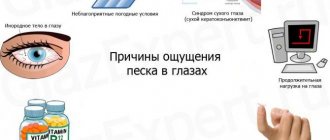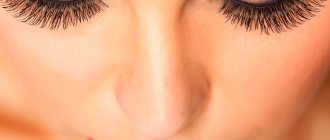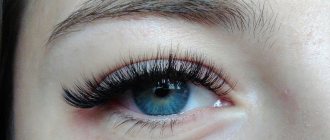The tissues of the visual system are characterized by increased sensitivity. At the slightest contact with a microscopic particle, a person feels discomfort.
Moving your eyelids and squeezing your eyes shut causes severe pain. The problem can be resolved by removing the foreign object.
This is not easy to do, especially if the grain of sand is not visible in the eyeball. We'll tell you in this article how to remove specks from under the upper and lower eyelids.
Signs of a speck getting under the eyelid
A person does not always record the moment a speck hits the eye. Sometimes there is not even an idea of what caused the unpleasant sensations. Some factors indicating the presence of a foreign body are similar to the symptoms of ophthalmological diseases. Therefore, the main guidelines are the following:
- sensation of scratching the tissues of the eye during active blinking;
- irritation of the mucous membrane, redness of the conjunctiva;
- increasing swelling;
- difficulty opening the upper eyelid;
- burning, itching, pain, negative reaction to daylight;
- Decreased quality of vision; a sort of veil interferes with reproducing a clear picture.
The listed manifestations occur against the background of the protective functions of the visual system, which is trying to get rid of a foreign object. The effect is enhanced by the abundant secretion of tear fluid.
Preparing for extraction
Before you begin removing the speck, you should prepare everything you need for the procedure. You will need a clean handkerchief or a piece of light-colored fabric. Color in this case is important only for identifying the speck after being caught in a homemade trap.
Cotton swabs and a sterile container with boiled water (or soy solution) may also come in handy. Hands must be washed thoroughly using detergent.
The second stage of preparation is to search for a foreign particle in the eyeball. First, looking in the mirror, slightly move the lower eyelid. Inspection is carried out in any direction between the corners. Then the area behind the upper eyelid is examined in a similar manner. You can also find a speck by opening your eyelids and slowly moving your gaze left and right.
The easiest way to solve the problem is to drive away the speck with tears. At the same time, it is prohibited to close your eyes tightly or rub them with your hands. This can provoke the deepening of a foreign body into the tissue of the visual organ. It will be very difficult to get a grain of sand.
Reference! If you can’t shed a tear, you need to use eye drops that are designed to moisturize. These products are called artificial tears.
Caring for the wound after a splinter
To prevent complications after removing a splinter, you need to properly treat the wound. To do this, follow the following rules:
- Remove any remaining contaminated blood from the hole by pressing lightly on the edges. There is no need to apply too much pressure; this can further injure the blood vessels.
- If there is bleeding, it is stopped with pressure (apply a gauze pad, wrap it with a bandage). Blood clots faster when positioned above the heart (you can raise your arm or leg for a few minutes). Usually, after removing the splinter, there is not much bleeding.
- After this, the wound is washed again with water, blotted with a napkin and antibacterial ointment is applied.
- Place a sterile gauze pad over the ointment and wrap it with a bandage.
The complete disappearance of symptoms after a splinter should occur in 5-7 days.
This time is enough for the wound to heal.
It is important to remember that a splinter, although a minor injury, can lead to serious consequences.
You should immediately consult a doctor in the following situations: very severe pain indicating nerve injury, severe bleeding, soil contamination (risk of developing tetanus infection), eye injury or splinters exceeding 5 mm in length.
The best ways to remove specks at home
There are many methods for removing grains of sand from the eye. As an example, the most effective methods that do not require special knowledge and skills are given.
By water
If the speck is located on the surface of the mucous membrane, it can be removed with liquid. To do this, boiled water (cooled to room temperature) is poured into a large container. The upper part of the face (eye area) needs to be immersed in water. Make a few leisurely blinks.
An abundant amount of moisture helps the grains of sand to come out. It is worth checking the result in front of a mirror. Having left the area under the eyelids, the speck may get stuck in the corners. If the discomfort has disappeared, the eye rinsing procedure was successful. Extracting a grain of sand with water is considered the most painless way.
Eye drops
If it is not possible to cause excessive tearing, it is recommended to use eye drops. They are prescribed mainly for dry eye syndrome, when the process of tear production is disrupted.
The following ophthalmic solutions can be used as artificial tears:
- Oksial;
- Hyphenation;
- Artificial tear;
- Slesin;
- Natural tear;
- Vidisik.
2-3 drops are injected into each eye. Afterwards, several movements of the eyelids are performed, but very slowly, so as not to damage the eye tissue. Rubbing with hands or a napkin is prohibited. You can turn your pupils around with your eyelids closed. After the manipulations, the eyeball is examined to detect specks. When it reaches a comfortable area, it is removed using the tip of a clean handkerchief (pre-moistened).
Cotton swab
You can also pick up a speck with a cotton swab. You need to act carefully so as not to damage the conjunctiva. After determining the place where the grain of sand is located, the tip of a cotton swab is moistened in boiled water, and the upper or lower eyelid is pulled back with your free hand. All that remains is to remove the foreign body with deft movements.
The procedure ends with washing the eye with antiseptic drops. This will help avoid infection.
How to remove a splinter from your foot
To remove a splinter from the foot, you can use two methods.
Needle
Wash your foot with soap to prevent infection from getting into the wound. Examine the splinter carefully. Pay attention to how it entered - all or the tip remained.
To quickly get rid of a splinter, steam your foot in warm water with salt. Use bright lighting and a magnifying glass. Treat the needle with alcohol and use it to lift the skin, as if pushing a splinter to the surface. Grasp the splinter with tweezers. Treat the area with a sponge in alcohol.
If the splinter is deep
You will need baking soda, cotton wool, adhesive tape and some water. Dissolve a teaspoon of baking soda in water to the consistency of thick sour cream. Apply to a cotton ball and place on the area with the splinter. Secure with a criss-cross tape. Leave for 1-2 hours. Take cosmetic tweezers and cut off the softened skin in which the splinter will be visible.
If the splinter is deep and you can’t get it out, go to the emergency room.
Removing metal debris
When working on machines or other metal processing, chips often get into the eye. This is one of the most dangerous types of mote. A hard, pointed object easily penetrates deep into the tissue. With careless manipulations, the damage area increases, the foreign body hides in the conjunctiva. It is very difficult to detect and extract.
Therefore, doctors do not advise trying to remove the metal speck yourself. It is also prohibited to impact the eyes in any way. Friction or rhythmic blinking causes not only pain, but also further tissue injury.
Reference! You can remove a metal speck on your own only if it is placed on the surface of the mucous membrane. It is recommended to take help from loved ones.
If the shavings are embedded in the tissue of the eyelid or the eyeball, there is no need to take measures to remove them. It is better to go to the clinic as soon as possible. The foreign object is removed there with special tools with a magnet at the tip. Until you arrive at the hospital, it is advisable to keep your eyes open and try not to make rhythmic movements with them. It is prohibited to apply bandages over the injured organ of vision.
Extraction
How to remove cotton wool from your ear yourself? Caution must be exercised. Warm vegetable oil or a few drops of hydrogen peroxide (5%) are dripped into the ear. You should lie on it for 20-30 minutes. During this period, the stuck piece should come out or move towards the exit. Then it should be carefully removed with tweezers. The ear must be pulled back and down to straighten the ear canal.
If cotton wool is stuck in the ear, it is advisable that one of your relatives perform the procedure for removing it. A pre-moistened piece of cotton wool can be removed with a crochet hook. The procedure must be performed in good lighting. If the cotton wool is not deep, but you can’t hook it with your finger, then wrap an adhesive plaster or tape around the tip of your finger with the sticky side out.
How to remove cotton wool from a child's ear? It is advisable not to perform the procedure yourself, as the baby may twitch, which will lead to big problems. Children must be treated by a doctor.
How to remove a speck from another person
You can remove specks from another person's eye using cotton swabs or a clean handkerchief. It is folded so that a loose corner is formed. They use it to pick up a grain of sand and pull it out.
First, the assistant should wash his hands. All items used must also be clean. Next, a search for a foreign body is carried out. To do this, remove the eyelids one by one and ask the victim to slowly make circular movements with the pupils.
If you can’t pick up the speck with a handkerchief or cotton swab, you need to use a saline solution (200 ml of boiled water, ½ tsp of table salt). It is administered using a pipette. A single dose is equal to its volume. The eye is washed with the prepared solution repeatedly. Salt water helps push grains of sand out of the conjunctiva. All that remains is to grab it with a twist from a handkerchief.
The child has
If a speck gets into a child’s eye, you must first examine the affected organ of vision. After identifying its location, extraction is carried out using water, a clean napkin or a cotton swab. Ideally, the grain of sand comes out along with the liquid.
If a foreign body penetrates the conjunctival sac, it is recommended to wash the grain of sand with a small amount of liquid. This is done with a piece of cotton wool. It is moistened in boiled water and lightly squeezed directly into the eye. The jet should be directed into the eye cavity (not at the pupil). A sterile syringe without a needle can be used as a water supply device.
Important! An adult should warn the child against touching the eye with hands or other objects. You need to ask the baby to lie down and completely relax to relieve stress.
If attempts to remove a foreign body do not bring a positive result, it is recommended to urgently consult an ophthalmologist. Prompt medical attention is especially important if metal shavings or glass shards enter the eye. Any manipulation is fraught with serious consequences, so you should not hesitate to go to the clinic.
How to remove a splinter from your finger
There are several ways to remove a splinter. It all depends on its size, material, how deep it goes, and where it is located.
To remove a splinter from your finger, you can use one of the remedies given below.
Hydrogen peroxide
- Moisten a sponge with hydrogen peroxide and wipe the affected area. The skin will become soft.
- Take tweezers and remove the splinter.
Baths with salt and soda
- Pour warm water into a bowl. Add 1 teaspoon of soda and 1 tbsp. spoon of salt.
- If desired, add two drops of lavender oil. It has antibacterial properties.
- Steam the arm or leg into which you have driven a splinter. To remove, use a needle and tweezers disinfected with alcohol.
Needle and tweezers
- Wash your hands with soap and dry with a towel.
- Examine the splinter. If it is small, use a magnifying glass. It will help you see in which direction to pull it out of the skin.
- If part of the splinter is visible, use tweezers treated with alcohol.
- Pull it out in the direction it hit.
- If the splinter is deep, use a needle disinfected with alcohol. Use it to pull the splinter to the surface of the skin. Pull the emerging end of the splinter evenly with tweezers.
In what cases is medical assistance needed?
Of course, you need to try to remove the speck on your own, but experts identify cases when you cannot do without medical help. For example, you should not take any action if the pain increases. Significant changes in eye tissue should also alert you. A trip to the clinic is inevitable if the foreign body cannot be found, but there are all signs of its presence.
An ophthalmologist, using special instruments and equipment, will be able to determine the location of a grain of sand of any size. Microscopic specks are identified using a dye composition.
Cases when you cannot do without medical help:
- the foreign body is not visible, but its presence in the eye is clearly felt;
- redness of eye tissue;
- swelling formation;
- ingress of metal shavings;
- profuse lacrimation, discharge of pus;
- photophobia;
- a sharp drop in visual acuity.
What to do if the speck won’t come out
If you cannot wash away the speck with water, you can try to remove it with a saline solution. To do this, the liquid is injected into the eye cavity with a pipette. The procedure must be repeated accompanied by slow circular movements with the pupils. If the pain increases, you need to use another washout option. To perform it, take a basin with warm water and immerse the upper part of the face (eye area) in it.
Underwater, with eyes open, make several movements with the pupils. This painless method of washing away debris almost always works. If there is no result, you should contact an ophthalmologist.
The speck becomes more mobile if you pull the upper or lower eyelid with your hands (depending on the location of the grain of sand) and begin to move the pupil in different directions.
There is another way to remove a foreign body. To do this, the eyelid is turned inside out. If a grain of sand is stuck on the internal tissues of the eyelid, a stream from a syringe (without a needle) is directed at it. For open access, use a cotton swab dipped in water.
How to pull it out if it is not visible
If during examination the speck was not detected, but there are symptoms of its presence, you need to rinse the eye with boiled water or use saline solution for the procedure. In this case, any effects on the organ of vision are excluded. When you rub your eyelids or close your eyes, a tiny particle can penetrate the tissue. After this, it will be impossible to remove it yourself.
Another way to identify the location of an invisible speck is to pull back the upper eyelid and hold it in this position. In this case, you need to perform several circular movements with the pupil. This must be done slowly so that the flow of intraocular fluid can push the grain of sand out. If the eye is dry before manipulation, it is recommended to inject eye drops into the conjunctival sac to replace the functions of tears.
Reference! After removing the speck, you should see an ophthalmologist. During the process of removing the foreign body, tissue could be damaged, which requires treatment.
You can detect the speck by everting your eyelid. This opens the conjunctival cavity to maximum visibility. This research should be entrusted to the shoulders of an assistant. In the absence of interference, it is easier to identify the provocateur of discomfort in the eye.
What should you do to avoid getting into such situations?
In the previous paragraph, we identified all the reasons that can cause trouble with a stuck key. In general, everything is clear; it is important to use the mechanism and key correctly so as not to get into such difficult situations:
- We use the key only for its intended purpose.
- Keys and locks are not toys for children; buy toy mechanisms for your children.
- Only the key intended for it should be inserted into the key hole and nothing else.
- If you lose the original key, order a duplicate from a reliable, trusted place; it’s better to overpay than to install a new mechanism.
- The door should be opened and closed very carefully, without impacts, force, etc.
- If the door leaf is skewed, it should be corrected immediately by calling a specialist to avoid additional problems.
- The keyhole must be cleaned regularly. This is done using a syringe or syringe, which is used to pour kerosene or motor oil into the mechanism. We continue cleaning by inserting the key into the keyhole several times and pulling it out, wiping off any dirt that has stuck to it. To ensure that the oil evenly lubricates each part of the mechanism, you need to turn the key several times.
Important . Do not leave small children alone at home; even to take out the trash, the lock may not open, and the child will be very scared.
If you are not sure that you can cope with the current situation on your own, then seek help from a specialist.
The lock and key on the door leading to an apartment or house have become so familiar to people that they do not pay attention to these mechanisms. We do not think when we open or close the front door, doing everything mechanically on the run, often ignoring accuracy. And there is no question of monitoring the lock mechanism at all; no one ever thinks about it. Then, one unlucky day, we receive a key that is stuck in the keyhole or, even worse, a piece of it.
If such a situation occurs, it is important not to panic, as it will only worsen the situation. If things can be postponed, then wait for the master; it is better to pay him for the work and, if possible, preserve the locking mechanism, than to waste your energy and break the mechanism in the absence of experience.
Precautionary measures
To prevent eye problems, doctors recommend not taking unnecessary actions when removing a speck. Need to exclude:
- use of sharp objects (needles, toothpicks, etc.);
- use of tweezers;
- rubbing of eye tissues;
- severe squeezing;
- applying compresses.
Eyes should be kept open. The victim is asked to sit down or lie down so that he can relax. Do not try to remove a grain of sand with a dry cloth. This will cause unnecessary problems. In addition, villi will remain on the mucous membrane, which also provoke discomfort.
Important! All items used must be sterile. Otherwise, there is a risk of eye infection.
Washing is the best way to remove a foreign body. But doing it under running water is irresponsible. Usually, such a decision is fraught with the penetration of specks even deeper under the eyelids.
If attempts to get rid of a grain of sand for 5-10 minutes do not lead to anything, there is no need to delay going to the clinic. Further manipulations will harm the health of the eyes.
It is easier to prevent any problem than to eliminate the consequences. Therefore, when processing metal or wood workpieces, you should wear safety glasses. This will prevent the ingress of small particles when sprayed with a tool. Similar precautions must be taken when riding a motorcycle, bicycle, or playing with a ball on the beach.
What to do after freeing your eye from specks
After the foreign body has been removed from the eye, the victim continues to experience pain and tissue irritation for some time. These are natural symptoms, so there is no need to worry. This phenomenon is due to the activation of the regenerative function.
If the pain is unobtrusive, you need to be patient a little. It will stop completely within 24 hours. Accelerate the process of cell restoration with eye drops. Among the safe products, the following options stand out: Vizin, Slezin. Ophthalmic solutions do not contain synthetic compounds. The effect is noticeable almost immediately after introducing the drops into the conjunctival sac. There are no negative effects on eye health.
As an alternative, it is recommended to use regular eye rinses with tea. There is no need to make the brew strong; a weakly concentrated liquid will do the job. The folk remedy provides an anti-inflammatory effect and quickly relieves tissue irritation.
Video on the topic:
A thorn in the eye doesn't hurt
What to do if a foreign body: iron scale, metal shavings, speck or eyelash gets into the eye? It is necessary to remove the foreign body from the eye as quickly as possible and do it correctly, without pushing it even deeper.
A speck or eyelash is a common thing, it can be easily removed at home or comes out on its own with a tear, but what to do when a splinter made of wood or metal has penetrated the cornea of the eye... Here the situation is more serious.
Remember: wood or any organic matter (organic substance) must be removed from the eye as quickly as possible. The same can be said about copper and aluminum shavings. Before one day has passed, the toxic oxidation products of non-ferrous metal enter into a chemical reaction with living tissue and fluids of the eye, the complications are very serious - blindness or complete loss of the eye.
Iron or steel shavings or scale flying off from welding slag can still remain in the eye for a couple of days, although a bedsore develops and traces of rust appear.
I have had different cases in my practice. People came with pieces of brick, coal, and stone stuck into their corneas. It is difficult to remove coal and brick from the eye - they crumble until you get everything out. But I think the hardest thing is removing the metal splinter from the grinder. Hot metal in the form of a spark enters the open eye and quickly goes out and cools down. The foreign body penetrates deeply, breaks off and crumbles when removed. You have to pick and pick with a syringe needle under constant dripping of 2% lidocaine into the sore eye, sweat flows from you and the patient, your hands are shaking.
When inserted into the outer shell of the eye, a foreign body is removed using a needle from a two-gram syringe. You shouldn’t even use an ophthalmological “spear”; it unfolds the corneal tissue; working with a needle is much more careful.
You can’t: remove foreign bodies from the eye with a match, tongue, or risky cotton swab - you can push the foreign body even further.
If someone has gotten their tongue into your eye before you, don’t even bother removing scale (chips, splinters). If inflammation occurs after contact with the tongue, the person’s eyeball should be removed, and they may blame you for this, because you were the last one who tried to help the person with a needle and anesthetic, and they won’t even remember about the “traditional” healer that it was he who brought the infection!
Remember: if there is a foreign body, you cannot:
- rub your eye
- blink frequently
- close your eyes,
- rinse your eyes with tap water,
- drip honey, aloe juice and other folk remedies into the eye.
If scale or chips get into the eye, they are removed in the ophthalmology office of the eye doctor. Remember that the patient must be vaccinated against tetanus.
After removal, the doctor prescribes eye drops with an antibiotic, for example tsiprolet, tsipromed, chloramphenicol drops and others. When there is a wound on the cornea, it is useful to place solcoseryl gel or Actovegin jelly behind the lower eyelid to accelerate healing of the cornea without scars.
If an eyelash, sawdust, or midge gets into your eye and they cannot stick in, then blink lightly and pull the upper eyelid outward, stimulating lacrimation. The foreign body will gradually be washed away by the tear, and you will remove it from the corner of the eye with a cotton swab.
What to do if scale or chips get into your eye?
Alexey Lukyanov's video channel talks about what to do if scale (metal shavings) gets into your eye? We provide an answer from an ophthalmologist on the website of the Moscow Eye Clinic on this problem.
Always follow safety precautions when carrying out welding work! Take care of yourself, colleagues! An indicative video is provided on how to use medical ophthalmological instruments to remove metal scale (slag from welding metal) from the victim’s eye.
Fragment of the program “Live Healthy!” on how to remove a foreign body from the surface of the eyeball. See how quickly and easily you can remove a speck from your eye.
By nature, our eyes are protected by eyelashes, but sometimes this protection is not enough. And various small particles get into your eyes. In many cases, it is almost impossible to protect yourself from this.
People often suffer and find themselves in such situations due to the specifics of their profession. When working with an angle grinder, almost everyone has encountered this problem.
And the eyes are an organ that needs to be protected. Any foreign substance should be removed from the eye as quickly as possible. One day is enough for toxic oxidation products of non-ferrous metal to enter into a chemical reaction with living tissue and fluids of the eye.
This should not be allowed, as the complications are very serious. You can become permanently blind or lose an eye . Therefore, in a situation where shavings from an angle grinder get into the hole, it is very important to know what should be done at home.
Sometimes the victim manages to independently remove the foreign body from the eye. But often the problem arises during the work process. And when dust and shavings fly in different directions, it is better to ask for outside help.
In any case, such a situation requires the right actions . This will make it possible to avoid serious consequences and preserve vision.
An unpleasant case where metal shavings get into the eye is considered mechanical damage. Depending on the severity, the following types of eye injuries are distinguished:
- Mild degree - does not threaten cosmetic defects or loss of vision.
- Moderate injury - slight cosmetic defect, slight decrease in vision.
- Severe degree - significant deterioration of vision or its complete loss as a result of the appearance of defects in the structure of the eye.
The location of the traumatic injury may be as follows:
- damage to the eyeball;
- eye sockets;
- accessory parts of the eye.
Main symptoms of damage:
- involuntary closing of the eyelids, it becomes difficult to open them independently;
- redness of the eye;
- pain in the eye area;
- secretion of tears;
- blurred vision.
These are the main signs of damage, but they do not make it possible to determine with high accuracy how badly the eye is damaged. The extent of damage can only be determined by an ophthalmologist using a microscope.
After removing the shavings from the grinder, the same symptoms may be observed, with the exception of severe lacrimation . Especially if the damage is deeper than the top layer of the corneal epithelium.
This occurs due to post-traumatic swelling. Therefore, even after correctly provided first aid, it is better to see a doctor .
If it is not possible to quickly get to a medical facility, then you need to know what to do on your own if scale from a grinder gets into your eye. All procedures must be performed with clean hands.
They should first be washed with soap and running water and should not be touched. Then follow these instructions:
- Rinse your face thoroughly with your eyes open.
- Try to determine the location of the foreign body. To do this, take a mirror and gently pull down the lower eyelid . Sometimes chips end up there. If present, remove it with a clean cotton swab pre-moistened with water. You can also do this with the tip of a scarf.
- If nothing is found in the lower eyelid, then you need to raise the upper eyelid . It is much more difficult to remove the speck from there. Carry out the procedure very carefully. Severe pain is possible. It is necessary to try to make it go down or fall out completely. To do this, take the upper eyelashes and tug them a little.
- If the discomfort continues, it means there is something left under the upper eyelid. You need to try to grab the top edge and turn it out a little. If there are shavings in this place, pull them out using a cotton swab.
- If the shavings are not stuck in the eye, you can fill a small container with warm boiled water and immerse your face in it . In this position, try to blink a little. This removes a foreign body if it is on the surface of the eye and is not stuck in it. This happens extremely rarely, because metal shavings almost always stick.
- An effective way to remove chips from your eye at home is to use a magnet . It should be brought as close as possible to the open eye and moved back and forth.
- If the metal shavings are not visible in the mirror, then there is a chance that they came out but scratched the cornea. Therefore, a person does not leave a feeling of discomfort. Then the affected eye must be instilled with antiseptic eye drops . You can also apply a restorative gel under the lower eyelid. Then close your eye and massage it with light, gentle movements.
- If your eyes become very rubbed during the extraction process , you can rinse them with the remnants of strong black tea. It contains tannins that relieve irritation. This procedure is available to everyone, since tea is always available in the house.
- If the chips have penetrated very deeply, it is better not to touch the eye and immediately seek medical help . If possible, do not blink or touch the injured eye with your hands.










